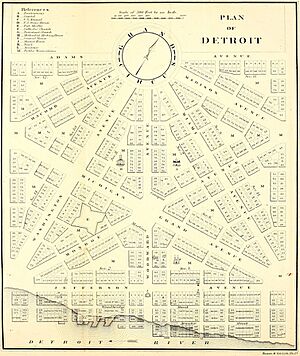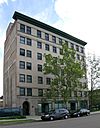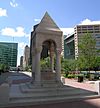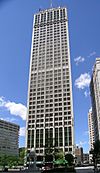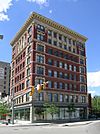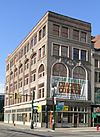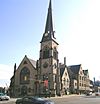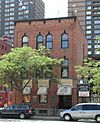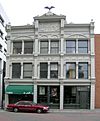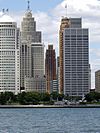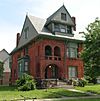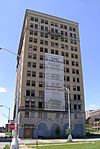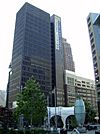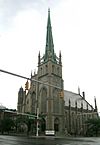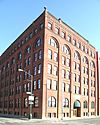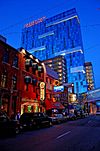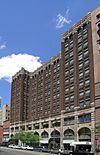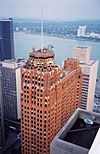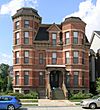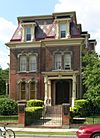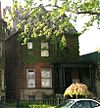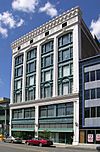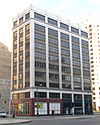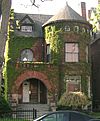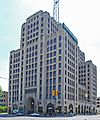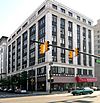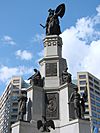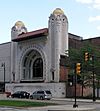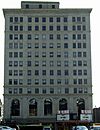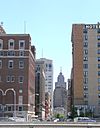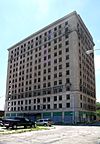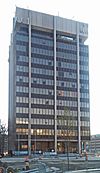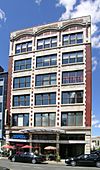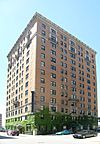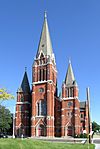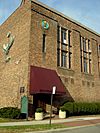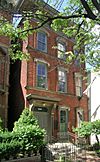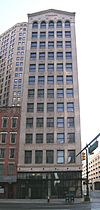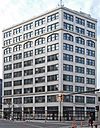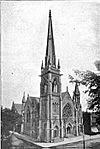National Register of Historic Places listings in Downtown and Midtown Detroit facts for kids
This is a list of important places in Downtown and Midtown Detroit, Michigan, that are on the National Register of Historic Places. These are special places that are kept safe because of their history. You can find their locations on online maps using the coordinates provided.
Contents
Exploring Downtown and Midtown Detroit
Downtown Detroit is an area bordered by the Lodge Freeway (M-10) to the west, the Fisher Freeway (I-75) to the north, Interstate 375 to the east, and the Detroit River to the south.
Midtown Detroit is located north of Downtown. It is bordered by the Chrysler Freeway (I-75) to the east, the Lodge Freeway to the west, the Edsel Ford Freeway (I-94) to the north, and the Fisher Freeway to the south. Midtown is also split by Woodward Avenue, which runs through its center.
- Wayne State neighborhood: West of Woodward and north of Warren.
- North Cass neighborhood: West of Woodward, south of Warren, and north of Martin Luther King.
- Cass Park neighborhood: West of Woodward and south of Martin Luther King.
- Art Center neighborhood: East of Woodward and north of Warren.
- Medical Center neighborhood: East of Woodward, south of Warren, and north of Mack.
- Brush Park neighborhood: East of Woodward and south of Mack.
There are 125 buildings and areas in Downtown and Midtown Detroit listed on the National Register. Five of these are extra special and are called National Historic Landmarks. In the rest of Detroit, there are 136 more listed places.
Detroit's Story: A City Through Time
How Detroit Began
Detroit was founded in 1701, making it one of the oldest cities in the Midwest. A huge fire in 1805 almost destroyed the entire city. After the fire, Judge Augustus B. Woodward created a new city plan. It had public parks and streets that spread out like spokes on a wheel from the city center. Even though his plan wasn't fully built, you can still see its basic shape in the heart of Detroit today.
After rebuilding in the early 1800s, Detroit grew quickly. By the time of the American Civil War, over 45,000 people lived there. Most lived along Jefferson Avenue to the east and Fort Street to the west. Some of the oldest buildings still standing are private homes. These include the Charles Trowbridge House (1826), the oldest known building in the city, and the Joseph Campau House (1835). Other old structures are Fort Wayne (1849), Saints Peter and Paul Church (1848), and Mariners' Church (1849).
Industry and Business Grow
As Detroit became a center for business and factories, the city expanded along the Detroit River. Many factories used the river and train lines for transportation. For example, the shipyard that became the Dry Dock Complex opened in 1852. Companies like Parke-Davis and Frederick Stearns & Company built large factories in the 1870s and 1890s. The Globe Tobacco Building was built in 1888.
With new industries came wealthy business owners and professionals. Some built fancy homes along East Jefferson Avenue. Others moved north of downtown, building houses along Woodward Avenue, which was a quiet area then. Some beautiful old homes from this time still exist, like the Elisha Taylor House (1870) and the Col. Frank J. Hecker House (1888). Later, apartment living became popular for middle-class families. Upscale apartments like the Coronado Apartments (1894) and the Palms Apartments (1903) were built. These wealthy residents also helped build many churches, including the Cass Avenue Methodist Episcopal Church (1883) and the Trinity Episcopal Church (1890).
People Come to Detroit
Detroit has always been a city of immigrants. French and English settlers came in the 1700s. Irish families settled in Corktown in the 1840s. Later, Greeks came to Greektown in the early 1900s. Many people from the Southern United States, including African Americans, also moved to Detroit before the Great Depression.
The industrial boom in the late 1800s brought even more immigrants. Many German and Polish immigrants arrived between the 1860s and 1890s. Germans built churches like St. John's-St. Luke's Evangelical Church (1872) and social clubs like the Harmonie Club (1894). Polish immigrants built many Roman Catholic churches, such as St. Albertus (1885) and Sweetest Heart of Mary (1893).
The Birth of the Automobile
Around 1900, people like Henry Ford started making cars in the Detroit area. They used the city's existing machine shops and coach-building skills. Early car factories include the Ford Piquette Avenue Plant (1904), which is a National Historic Landmark. Other early car-related buildings are found in the Piquette Avenue Industrial Historic District and the New Amsterdam Historic District.
Soon, car manufacturing became the most important industry in Detroit. New car company leaders built huge office buildings like the General Motors Building (1919) and the Fisher Building (1928).
How Cars Changed Detroit
The car industry needed many workers, so huge numbers of people moved to Detroit from Europe and the Southern United States. Between 1900 and 1930, Detroit's population grew from 265,000 to over 1.5 million! This growth pushed the city's borders outwards. Many apartment buildings were built for middle-class car workers, like the Somerset Apartments (1922).
New, fancy neighborhoods appeared further from the city center, such as Boston-Edison and Indian Village. Wealthy families moved to these areas. As the population spread, new churches were built, like the Cathedral of the Most Blessed Sacrament (1913) and the Woodward Avenue Presbyterian Church (1908).
The rise of cars also changed how people traveled in the city. New bridges and viaducts were built to separate car and train traffic, making travel smoother. Examples include the Chestnut Street-Grand Trunk Railroad bridge (1929).
The wealth from the car industry also led to a building boom in downtown Detroit. Many early 20th-century skyscrapers were built. The most famous is the Art Deco National Historic Landmark Guardian Building (1928). Other important buildings include the Vinton Building (1916) and the Barlum Tower (1927). Shopping areas grew along Park Avenue and Woodward. Many hotels were built, like the Fort Shelby Hotel (1916). Grand movie theaters, such as the Fox (1928), and public buildings like the Detroit Public Library (1921) were also constructed.
African-American History in Detroit
In Detroit's early years, the African-American population was small. However, the Second Baptist Church (founded in the 1830s) played a key role in the Underground Railroad, helping many enslaved people escape to Canada.
The car boom in the 1900s brought a huge increase in Detroit's Black population. In 1910, fewer than 6,000 Black people lived in the city; by 1917, over 30,000 did. Important African-American landmarks include Dunbar Hospital (founded 1914), which was the first hospital for the Black community in Detroit. The Sugar Hill neighborhood became a center for African-American entertainment. Buildings like the Breitmeyer-Tobin Building (1905) show how Black professionals found office space in the city.
Famous Architects of Detroit
Many famous architects worked in Detroit. Albert Kahn is especially known for his many different buildings in the city. He designed large factories like the Highland Park Ford Plant (1908), which is a National Historic Landmark.
Kahn also designed office buildings such as the General Motors Building (1919) and the Fisher Building (1928), both National Historic Landmarks. He also designed homes, apartments, hotels, churches, and theaters.
Current Historic Places
| Name on the Register | Image | Date listed | Location | Neighborhood | Description | |
|---|---|---|---|---|---|---|
| 1 | Architects Building |
(#95000531) |
415 Brainard St. 42°20′48″N 83°03′43″W / 42.346667°N 83.061944°W |
Midtown: Cass Park | This seven-story building was built in 1924. It was designed by Richard H. Marr, a famous Detroit architect. It was meant to be a place for all architectural businesses. Today, it has apartments for people with lower incomes. | |
| 2 | Bagley Memorial Fountain |
(#71000422) |
Woodward and Monroe Aves. 42°19′53″N 83°02′42″W / 42.331389°N 83.045°W |
Downtown | The Bagley Memorial Fountain was designed in 1885 by Henry Hobson Richardson. It was built using money left by John J. Bagley to provide cold, pure drinking water for Detroit's people. The fountain was moved to Cadillac Square Park in 2007. | |
| 3 | Barlum Tower |
(#05000737) |
65 Cadillac Sq. 42°19′54″N 83°02′42″W / 42.331736°N 83.044903°W |
Downtown | Built in 1927 by John J. Barlum, this was the first building outside Chicago or New York to have 40 floors. It was part of Barlum's plan to rebuild Cadillac Square. The building is now called the Cadillac Tower. | |
| 4 | Belcrest Hotel |
(#84001851) |
5440 Cass Ave. 42°21′36″N 83°04′07″W / 42.36°N 83.068611°W |
Midtown: Wayne State | The Belcrest Apartment Hotel was built in 1926. It was a fancy residential hotel for wealthy people. It offered hotel-like services such as daily maid service and a restaurant, which was a new idea for apartments at the time. | |
| 5 | William C. Boydell House |
(#82002892) |
4614 Cass Ave. 42°21′13″N 83°03′53″W / 42.353611°N 83.064722°W |
Midtown: North Cass | The William C. Boydell House is a double house, built in 1895. It was designed to look like one large family home. | |
| 6 | Breitmeyer-Tobin Building |
(#80001918) |
1308 Broadway St. 42°20′06″N 83°02′45″W / 42.335°N 83.045833°W |
Downtown | This eight-story building was built in 1905 for a florist company. In 1944, it became offices for Black professionals. Important African-American groups and lawyers had offices here. It is now called the Harmonie Centre. | |
| 7 | Broadway Avenue Historic District |
(#04000656) |
Broadway between Gratiot and Grand River Boulevard 42°20′06″N 83°02′46″W / 42.335°N 83.046111°W |
Downtown | This historic area on Broadway Avenue has eleven commercial buildings built between 1896 and 1926. It was a popular shopping area, especially for women's businesses. Three buildings here are also listed separately on the National Register. | |
| 8 | Capitol Park Historic District |
(#99000338) |
Roughly bounded by Grand River Ave., Woodward Ave., Michigan Ave., and Washington Boulevard 42°19′58″N 83°02′58″W / 42.332778°N 83.049444°W |
Downtown | Capitol Park is a triangular public park. A courthouse built here in 1823-28 became Michigan's state capitol in 1837. The Historic District includes the park and seventeen buildings around it, like the Farwell Building and the David Stott Building. | |
| 9 | Cary Building |
(#83003670) |
229 Gratiot Ave. 42°20′08″N 83°02′49″W / 42.335556°N 83.046944°W |
Downtown | The Cary Building was built in 1905. Its construction helped change Broadway (then called Miami Avenue) from a residential area into a trendy shopping district. | |
| 10 | Cass Avenue Methodist Episcopal Church |
(#82000548) |
3901 Cass Ave. 42°20′53″N 83°03′47″W / 42.348056°N 83.063056°W |
Midtown: North Cass | The first part of this church was designed in 1883 by Mason and Rice. The main part was designed in 1891 by Malcomson and Higginbotham. It is built in the Richardson Romanesque style. | |
| 11 | Cass Motor Sales |
(#86001039) |
5800 Cass Ave. 42°21′43″N 83°04′12″W / 42.362°N 83.07°W |
Midtown: Wayne State | The Cass Motor Sales building was designed and built in 1928. It shows the Art Deco style used for business buildings. It was originally a showroom and service center for Marmon Motor Company cars. | |
| 12 | Cass Park Historic District |
(#04001580) |
Temple, Ledyard, and 2nd at Cass Park 42°20′28″N 83°03′35″W / 42.341111°N 83.059722°W |
Midtown: Cass Park | This historic area surrounds Cass Park. It includes over 20 buildings, such as apartments, a hotel, the Detroit Masonic Temple, and Cass Technical High School. | |
| 13 | Lewis Cass Technical High School |
(#10000644) |
2421 Second Ave. 42°20′15″N 83°03′36″W / 42.3375°N 83.06°W |
Midtown: Cass Park | Cass Tech was built in 1922. It was Detroit's first technical high school and the city's only magnet school for many years. The building was used until 2005, when a new Cass Tech High School was built. The original building was taken down in July 2011. | |
| 14 | Cass-Davenport Historic District |
(#97001100) |
Roughly bounded Cass Ave., Davenport, and Martin Luther King Jr. Boulevard 42°20′46″N 83°03′40″W / 42.346111°N 83.061111°W |
Midtown: North Cass | This historic area includes four apartment buildings. Two are examples of small, fancy apartments from the early 1900s. The other two are larger, high-density apartments built between 1915 and 1930. | |
| 15 | Cathedral Church of St. Paul Complex |
(#82002893) |
4800 Woodward Ave. 42°21′22″N 83°03′50″W / 42.356111°N 83.063889°W |
Midtown: Medical Center | The Cathedral Church of St. Paul is the main church for the Episcopal Diocese of Michigan. It was designed by famous church architect Ralph Adams Cram. The bell tower was never finished. The church is made entirely of limestone using old building methods, without steel supports. | |
| 16 | Central United Methodist Church |
(#82002895) |
Woodward Ave. at E. Adams St. 42°20′15″N 83°03′03″W / 42.3375°N 83.050833°W |
Downtown | The Central United Methodist Church was first started in 1802. It was the first organized Protestant church in what was then the Michigan Territory. The current church building's cornerstone was laid on July 3, 1867. | |
| 17 | Century Building and Little Theatre |
(#85000993) |
333 Madison St. 42°20′15″N 83°02′47″W / 42.3375°N 83.046389°W |
Downtown | In 1902, the Twentieth Century Club built this Mission-style building. In 1928, a Spanish Revival-style addition was built for the Little Theater chain. In 1997, the buildings, now called the Gem Theatre, were moved five blocks. This was to make room for Comerica Park. It was the furthest known move of a large building. | |
| 18 | Chapel of St. Theresa-the Little Flower |
(#97001099) |
46 Parsons St. 42°20′54″N 83°03′36″W / 42.348333°N 83.06°W |
Midtown: North Cass | The Irish St. Patrick Parish in Detroit started in 1862. They built this chapel next to their school in 1892. This made it easier for students to attend church. After the old St. Patrick church burned in 1992, this chapel became the new St. Patrick Church. | |
| 19 | Alexander Chapoton House |
(#80001919) |
511 Beaubien St. 42°19′54″N 83°02′26″W / 42.3316°N 83.0406°W |
Downtown | This home is a Queen Anne style row house. It is one of the last examples left in the city. Alexander Chapoton, from one of Detroit's oldest families, built it. | |
| 20 | Chatsworth Apartments |
(#86001001) |
630 Merrick St. 42°21′27″N 83°04′16″W / 42.3575°N 83.071111°W |
Midtown: Wayne State | The Chatsworth Apartments is a nine-story building constructed in 1927. It was built with reinforced concrete and tan brick. It also had an underground parking garage for 65 cars, which was very unusual at that time. | |
| 21 | The Clay School |
(#82002913) |
453 Martin Luther King, Jr. Boulevard 42°20′42″N 83°03′42″W / 42.345°N 83.061667°W |
Midtown: North Cass | The Clay School, built in 1888, is the oldest school building still standing in Detroit. It was an elementary school and later a center for vocational studies. In 1981, it was turned into office space and is now called the Clay Office and Conference Center. | |
| 22 | Coronado Apartments |
(#82002897) |
3751-73 Second Ave. 42°20′49″N 83°03′52″W / 42.346944°N 83.064444°W |
Midtown: North Cass | The Coronado Apartments is a four-story building built in 1894. It was one of Detroit's first apartment buildings for wealthy middle-class families. Living in apartments was just becoming popular then. It was a fashionable address until the 1930s. | |
| 23 | Cultural Center Historic District |
(#83003791) |
5200, 5201 Woodward Ave., and 100 Farnsworth Ave. 42°21′31″N 83°03′57″W / 42.358611°N 83.065833°W |
Midtown: Art Center | This historic area includes three important buildings along Woodward Avenue: the Detroit Public Library, the Detroit Institute of Arts, and the Horace H. Rackham Education Memorial Building. | |
| 24 | Detroit Club |
(#04001577) |
712 Cass Ave. 42°19′47″N 83°03′03″W / 42.329722°N 83.050833°W |
Downtown | The Detroit Club is a four-story brick and stone building built in 1891. It was the third home for this club, which started in 1882. It was a place for local businessmen to meet. Famous early members included Russell A. Alger, a former Michigan governor. | |
| 25 | Detroit Cornice and Slate Company Building |
(#74001000) |
733 St. Antoine St. at E. Lafayette St. 42°20′04″N 83°02′26″W / 42.334444°N 83.040556°W |
Downtown | This building was designed in the Beaux-Arts style by architect Harry J. Rill. It was finished in 1897. Its fancy front is made from galvanized steel. Many decorations were made by the Detroit Cornice and Slate Company itself. | |
| 26 | Detroit Edison Company Willis Avenue Station |
(#97001097) |
50 W. Willis St. 42°21′06″N 83°03′43″W / 42.351667°N 83.061944°W |
Midtown: North Cass | The Willis Avenue station was the first steam power substation used by Detroit Edison. It produced steam heat for the city. Three other plants also serve Detroit's central heating system. | |
| 27 | Detroit Financial District |
(#09001067) |
Bounded by Woodward and Jefferson and Lafayette and Washington Boulevard 42°19′46″N 83°02′50″W / 42.329544°N 83.047342°W |
Downtown | This historic area was Detroit's financial center from the 1850s to the 1970s. It has some of the city's largest and most decorative skyscrapers. These include the Guardian Building and the Penobscot Building. | |
| 28 | Detroit Industry Murals, Detroit Institute of Arts |
(#14000279) |
5200 Woodward Ave. 42°21′34″N 83°03′52″W / 42.359423°N 83.064414°W |
Midtown: Art Center | These four large paintings at the Detroit Institute of Arts are considered the best work in the United States by Mexican artist Diego Rivera. They are famous modern artworks about industry. | |
| 29 | Detroit Masonic Temple |
(#80001920) |
500 Temple St. 42°20′30″N 83°03′37″W / 42.341667°N 83.060278°W |
Midtown: Cass Park | The 14-story Detroit Temple is the largest Masonic Temple in the world. It has a huge theater with 4,404 seats and two ballrooms. It was built in 1922. | |
| 30 | Detroit News Complex |
(#15000947) |
615 and 801 W. Lafayette Blvd. 42°19′43″N 83°03′15″W / 42.328598°N 83.054253°W |
Downtown | This building was home to the Detroit News offices from 1917 to 2013. It was also the site of the first commercial radio broadcast in the United States on station WWJ. | |
| 31 | Detroit-Columbia Central Office Building |
(#97001098) |
52 Selden St. 42°20′58″N 83°03′38″W / 42.349444°N 83.060556°W |
Midtown: North Cass | This Art Deco building was built in the 1920s for Michigan Bell's "dial system" offices. It is still owned by AT&T and is known as the Michigan Bell Telephone Exchange. | |
| 32 | Detroit-Leland Hotel |
(#05000718) |
400 Bagley St. 42°20′01″N 83°03′15″W / 42.333689°N 83.054261°W |
Downtown | The Detroit-Leland Hotel opened in 1927. It was named after Cadillac founder Henry M. Leland. It had 800 air-conditioned rooms, a dining room, and stores. | |
| 33 | Dunbar Hospital |
(#79001172) |
580 Frederick St. 42°21′42″N 83°03′32″W / 42.361667°N 83.058889°W |
Midtown: Art Center | The Dunbar Hospital was the first hospital in Detroit for the Black community. It was built in 1892 as a private home. In 1918, Dr. James W. Ames turned it into a hospital. It is now the Detroit Medical Society Headquarters. | |
| 34 | East Ferry Avenue Historic District |
(#80001921) |
E. Ferry Ave. 42°21′42″N 83°03′56″W / 42.361667°N 83.065556°W |
Midtown: Art Center | In the 1880s, D. M. Ferry developed his land into residential lots. East Ferry Avenue quickly became home to wealthy Detroit residents. Even though Woodward Avenue is now mostly commercial, the mansions on East Ferry still stand. | |
| 35 | Eddystone Hotel |
(#06000588) |
100-118 Sproat St. 42°20′30″N 83°03′25″W / 42.341667°N 83.056944°W |
Midtown: Cass Park | The Eddystone is one of three hotels on Park Avenue designed by Louis Kamper. The other two are the Royal Palm and the Park Avenue Hotel. | |
| 36 | Elwood Bar |
(#85001074) |
300 E. Adams St. 42°20′18″N 83°02′49″W / 42.338472°N 83.046944°W |
Downtown | The Elwood Bar was built in 1936. It was originally at 2100 Woodward Avenue but was moved to 300 Adams. Designed by Charles Noble, it's a great example of Art Moderne Style with cream and blue enameled steel. It is now called the Elwood Bar and Grill. | |
| 37 | Farwell Building |
(#76001037) |
1249 Griswold St. 42°20′00″N 83°03′00″W / 42.333333°N 83.05°W |
Downtown | The Farwell Building was completed in 1915. It has iron grillwork at the entrance and a beautiful interior with a Tiffany mosaic ceiling, brass elevator doors, and marble walls. | |
| 38 | Federal Reserve Bank of Chicago Detroit Branch Building |
(#07001491) |
160 W. Fort St. 42°19′51″N 83°02′56″W / 42.330833°N 83.048889°W |
Downtown | This building was constructed in 1927 in a Neoclassical style. In 1951, an eight-story modern glass-and-marble addition was designed by Minoru Yamasaki. | |
| 39 | First Congregational Church |
(#79001173) |
33 E. Forest Ave. 42°21′19″N 83°03′46″W / 42.355278°N 83.062778°W |
Midtown: North Cass | The First Congregational Church was built in 1891. An addition called the Angel's Wing was built in 1921 by Albert Kahn. The church has an 8-foot copper statue of the Archangel Uriel on top. | |
| 40 | First Federal Building |
(#13000906) |
1001 Woodward Ave. 42°19′55″N 83°02′51″W / 42.332027°N 83.047593°W |
Downtown | Now known as 1001 Woodward, this building was designed by Smith, Hinchman & Grylls. It was built between 1963-65 as the headquarters for First Federal Savings and Loan of Detroit. It is in the International Style. | |
| 41 | First Presbyterian Church |
(#79001174) |
2930 Woodward Ave. 42°20′39″N 83°03′19″W / 42.344167°N 83.055278°W |
Midtown: Brush Park | George D. Mason designed the First Presbyterian Church after Trinity Church in Boston. It is made from rough-cut red sandstone and shaped like a Greek cross. It is now used as the Ecumenical Theological Seminary. | |
| 42 | First Unitarian Church of Detroit |
(#82002899) |
2870 Woodward Ave. 42°20′38″N 83°03′19″W / 42.343889°N 83.055278°W |
Midtown: Brush Park | The First Unitarian Church of Detroit was designed by Donaldson and Meier in the Romanesque Revival style and finished in 1890. Sadly, it caught fire in 2014 and was later taken down. | |
| 43 | Fort Shelby Hotel |
(#83003695) |
525 W. Lafayette Boulevard 42°19′44″N 83°03′14″W / 42.328889°N 83.053889°W |
Downtown | The Fort Shelby is a 22-story Beaux-Arts hotel. It was built in two parts in 1916 and 1927. It closed in the 1970s but was bought in 2007 and reopened as the DoubleTree Guest Suites Fort Shelby Hotel. | |
| 44 | Fort Street Presbyterian Church |
(#71000424) |
631 W. Fort St. 42°19′39″N 83°03′14″W / 42.3275°N 83.054°W |
Downtown | The Fort Street Presbyterian Church was first built in 1855. It was completely rebuilt to its original plans after a fire in 1876. It is a top example of Gothic Revival architecture in America. | |
| 45 | Fox Theatre Building |
(#85000280) |
2211 Woodward Ave. 42°20′18″N 83°03′09″W / 42.338333°N 83.0525°W |
Downtown | The Detroit Fox is the largest of the Fox Theatres. Built in 1928 for William Fox, it was the first movie palace with live sound. The architect, C. Howard Crane, designed a very fancy interior with styles from different countries. It was restored in 1988. | |
| 46 | Charles Lang Freer House |
(#71000426) |
71 E. Ferry Ave. 42°21′43″N 83°03′57″W / 42.361944°N 83.065833°W |
Midtown: Art Center | This home was built by Charles Lang Freer, a businessman and art collector. He helped start the Peninsular Car Company. It is now the Merrill Palmer Institute of Human Development & Family Life of Wayne State University. | |
| 47 | GAR Building |
(#86000262) |
1942 Grand River Ave. 42°20′06″N 83°03′19″W / 42.335°N 83.055278°W |
Downtown | The Grand Army of the Republic (GAR) Building was built as a meeting hall for the Grand Army of the Republic. This was a group of soldiers who fought in the American Civil War. | |
| 48 | Garden Bowl |
(#08000578) |
4104-4120 Woodward Ave. 42°21′05″N 83°03′36″W / 42.35125°N 83.06°W |
Midtown: Medical Center | The Garden Bowl was built in 1913. It is Detroit's oldest bowling alley that has been open continuously. In 1934, the front part of the building was removed when Woodward Avenue was made wider. | |
| 49 | Edwin S. George Building |
(#93000651) |
4612 Woodward Ave. 42°21′15″N 83°03′44″W / 42.354167°N 83.062222°W |
Midtown: Medical Center | In 1908, Edwin S. George hired architect Albert Kahn to design a two-story building for car parts suppliers. In 1914, George added three more floors, also designed by Kahn, and renamed it the "Garfield Building." | |
| 50 | Bernard Ginsburg House |
(#91001015) |
236 Adelaide St. 42°20′34″N 83°03′05″W / 42.342778°N 83.051389°W |
Midtown: Brush Park | Bernard Ginsburg was important for his charity work and for the Jewish community in Detroit. He asked young architect Albert Kahn to design this house. It has unique and beautiful statues supporting the porch roof. | |
| 51 | Globe Tobacco Building |
(#84000442) |
407 E. Fort St. 42°19′59″N 83°02′34″W / 42.333056°N 83.042778°W |
Downtown | Cigar making was once Detroit's biggest industry. Globe Tobacco was one of the largest cigar makers. They built this factory in 1888. | |
| 52 | Grand Circus Park Historic District |
(#83000894) |
Roughly bounded by Clifford, John R. and Adams Sts.; also 25 W. Elizabeth 42°20′10″N 83°03′02″W / 42.336111°N 83.050556°W |
Downtown | The Grand Circus Park Historic District includes the 5-acre Grand Circus Park, which is split by Woodward Avenue. Important buildings around the park include the David Broderick Tower and Comerica Park. | |
| 53 | Graybar Electric Company Building |
(#97001096) |
55 W. Canfield St. 42°21′08″N 83°03′45″W / 42.352222°N 83.0625°W |
Midtown: North Cass | This warehouse building was rented by the Graybar Electric Company from 1926 to the 1940s. It has been turned into loft apartments and is now called the Lofts at 55 West Canfield. | |
| 54 | Greektown Historic District |
(#82002902) |
Monroe Ave., between Brush and St. Antoine Sts. 42°20′06″N 83°02′32″W / 42.335°N 83.042222°W |
Downtown | Greektown is a shopping area that spans two city blocks. It includes the St. Mary Roman Catholic Church and the Second Baptist Church. The area has many Greek restaurants and shops. | |
| 55 | Robert M. and Matilda (Kitch) Grindley House |
(#97001475) |
123 Parsons St. 42°20′51″N 83°03′39″W / 42.3475°N 83.060833°W |
Midtown: North Cass | The Robert and Matilda Kitch Grindley House was built in 1897 for the Grindley family. They were important in Detroit's charity community. The house was taken down in 1998. | |
| 56 | Griswold Building |
(#80001923) |
1214 Griswold St. 42°19′59″N 83°02′56″W / 42.333056°N 83.048889°W |
Downtown | This 12-story building is important because it shows architect Albert Kahn's change in style from Art Deco to Art Moderne. It is now the Griswold Building Senior Apartments. | |
| 57 | Guardian Building |
(#89001165) |
500 Griswold St. 42°19′47″N 83°02′45″W / 42.329722°N 83.045833°W |
Downtown | The Guardian Building is a National Historic Landmark and a great example of Art Deco architecture. Its outside mixes brick, tile, limestone, and terracotta. The inside is richly decorated with mosaics and special tiles. | |
| 58 | The Harmonie Club |
(#80001924) |
267 E. Grand River Ave. 42°20′11″N 83°02′48″W / 42.336389°N 83.046667°W |
Downtown | The Harmonie Club is a four-story building made of buff-colored brick and stone. It was built by the Gesang-Verein Harmonie, a German singing club started in 1849. | |
| 59 | John Harvey House |
(#91000354) |
97 Winder St. 42°20′30″N 83°03′08″W / 42.341667°N 83.052222°W |
Midtown: Brush Park | John Harvey was a successful pharmacist known for his charity work with poor children. He built this large mansion in 1887. The current owners bought it in 1986 and opened it as The Inn at 97 Winder in 2005. | |
| 60 | Col. Frank J. Hecker House |
(#71000427) |
5510 Woodward Ave. 42°21′42″N 83°04′01″W / 42.361667°N 83.066944°W |
Midtown: Art Center | Col. Frank J. Hecker started the Peninsular Car Company. In 1888, he built this 49-room mansion. He hosted many famous guests here, including Presidents William McKinley and Rutherford B. Hayes. | |
| 61 | Hotel Stevenson |
(#97001095) |
40 Davenport St. 42°20′50″N 83°03′33″W / 42.347222°N 83.059167°W |
Midtown: North Cass | This building, built in 1913, was designed as an apartment hotel. It offered smaller units for the many male workers who came to Detroit for the booming car industry. | |
| 62 | Hudson-Evans House |
(#75000966) |
79 Alfred St. 42°20′37″N 83°03′13″W / 42.3435°N 83.0535°W |
Midtown: Brush Park | The Hudson-Evans House was built around 1872-73 for Philo Wright, a ship owner. In 1882, it was given as a wedding gift to Grace Whitney Evans. Between 1894 and 1904, Joseph Lowthian Hudson, who founded the J.L. Hudson Company department store, rented the house. | |
| 63 | Mulford T. Hunter House |
(#94000757) |
77 W. Hancock St. 42°21′19″N 83°03′53″W / 42.355278°N 83.064722°W |
Midtown: North Cass | This is a Queen Anne townhouse. It is one of the few remaining examples in Detroit. It is next to the George W. Loomer House. These two are the only 19th-century buildings left in what was once a very fashionable area. | |
| 64 | Jefferson Intermediate School |
(#97001094) |
938 Selden St. 42°20′48″N 83°04′07″W / 42.346667°N 83.068611°W |
Midtown: North Cass | An elementary school was built here in 1873. In 1922, the old building was replaced with the current one, finished in 1923. As of 2008, the building is a charter school. It is also known as Jefferson Junior High School. | |
| 65 | Albert Kahn House |
(#72000668) |
208 Mack Ave. 42°20′54″N 83°03′21″W / 42.348333°N 83.055833°W |
Midtown: Brush Park | In 1906, architect Albert Kahn built this home for himself. He lived there until he passed away in 1942. The house is in the English Renaissance style but looks modern. It is now the offices for the Detroit Urban League. | |
| 66 | L. B. King and Company Building |
(#87000927) |
1274 Library St. 42°20′05″N 83°02′51″W / 42.334722°N 83.0475°W |
Downtown | The L. B. King Company was a china wholesaler. They built this white terracotta-covered office building in 1910. The company moved out in 1932. The building is also known as the Annis Furs Building. | |
| 67 | S. S. Kresge World Headquarters |
(#79001175) |
2727 2nd Ave. 42°20′24″N 83°03′43″W / 42.34°N 83.061944°W |
Midtown: Cass Park | The Kresge World Headquarters is a limestone building designed in 1928 by Albert Kahn. It was for S.S. Kresge, now K-Mart. The building won awards for its unique horizontal design. | |
| 68 | Lancaster and Waumbek Apartments |
(#97000921) |
227-29 and 237-39 E. Palmer Ave. 42°21′47″N 83°03′55″W / 42.363078°N 83.065278°W |
Midtown: Art Center | The Lancaster and Waumbek Apartments were two similar three-story apartment buildings. They were good examples of early 1900s apartment houses in Detroit. They were taken down in November 2005. | |
| 69 | Lawyers Building |
(#82002903) |
137 Cadillac Sq. 42°19′55″N 83°02′38″W / 42.331944°N 83.043889°W |
Downtown | The Lawyers Building, also called the "American Title Building," was built in 1922 by John J. Barlum. It was part of his plan to improve Cadillac Square. This ten-story building originally had offices for middle-class groups. | |
| 70 | League of Catholic Women Building |
(#97001093) |
100 Parsons St. 42°20′52″N 83°03′41″W / 42.347778°N 83.061389°W |
Midtown: North Cass | This building was constructed in 1927 by the League of Catholic Women. It provided housing for young single women working in the city. In 1982, it was turned into 82 apartments for low-income elderly or handicapped residents. | |
| 71 | George W. Loomer House |
(#94000753) |
71 W. Hancock St. 42°21′20″N 83°03′52″W / 42.355556°N 83.064444°W |
Midtown: North Cass | The George W. Loomer House is a private home built in the Richardsonian Romanesque style. It is next to the Mulford T. Hunter House. These two are the only 19th-century buildings left in what was once a very fashionable area. | |
| 72 | Lower Woodward Avenue Historic District |
(#99000051) |
1202–1449 and 1400–1456 Woodward Ave. 42°20′03″N 83°02′56″W / 42.334167°N 83.048889°W |
Downtown | This historic area has 34 commercial buildings built around the late 1800s and early 1900s. By the 1920s, this was one of the busiest shopping areas in the country. | |
| 73 | Maccabees Building |
(#83003436) |
5057 Woodward Ave. 42°21′28″N 83°03′56″W / 42.357778°N 83.065556°W |
Midtown: Wayne State | This building was first built for the Knights of the Maccabees, a fraternal organization. Extra space was rented to other businesses, including stores and offices. Detroit's radio and TV station WXYZ was once a tenant. | |
| 74 | Majestic Theater |
(#08000577) |
4140 Woodward Ave. 42°21′05″N 83°03′37″W / 42.351389°N 83.060278°W |
Midtown: Medical Center | The Majestic Theater, designed by C. Howard Crane, opened in 1915. It was the largest theater in the world built for showing movies at the time. In 1934, part of the front was removed when Woodward Avenue was widened. | |
| 75 | Mariners' Church |
(#71000428) |
170 E. Jefferson Ave. 42°19′46″N 83°02′31″W / 42.329444°N 83.041944°W |
Downtown | Mariners' Church of Detroit is an Anglican church. It was started in 1842, and the current building was built in 1849. | |
| 76 | Perry McAdow House |
(#80004405) |
4605 Cass Ave. 42°21′11″N 83°03′56″W / 42.353056°N 83.065556°W |
Midtown: North Cass | Perry W. McAdow made his money from gold mining. In 1891, he and his wife built this fancy mansion on Cass Avenue. It cost $65,000, which was a lot of money then. | |
| 77 | McGregor Memorial Conference Center |
(#10001023) |
495 Ferry Mall 42°21′34″N 83°04′15″W / 42.359519°N 83.070722°W |
Midtown: Wayne State | Finished in 1958, the McGregor Memorial Conference Center was the first big project for architect Minoru Yamasaki after his trip to Japan. It was praised by architecture magazines as "delightful" and "refreshing." | |
| 78 | Merchants Building |
(#83003732) |
206 E. Grand River Boulevard 42°20′05″N 83°02′45″W / 42.334722°N 83.045833°W |
Downtown | The eight-story Merchants Building is made of steel, concrete, and terracotta. Throughout its history, it has housed many businesses, including fur shops, a grocery store, and an insurance company. | |
| 79 | Michigan Soldiers' and Sailors' Monument |
(#84001862) |
Woodward Ave. at Campus Martius 42°19′54″N 83°02′48″W / 42.331667°N 83.046667°W |
Downtown | Sculptor Randolph Rogers designed this monument. It has sections that rise up, topped by eagles and figures representing the Navy, Infantry, Cavalry, and Artillery. Four female figures representing Victory, History, Emancipation, and Union were added in 1881. | |
| 80 | Midtown Woodward Historic District |
(#08001106) |
2951-3424 Woodward Ave., 14 Charlotte St., 10 and 25 Peterboro St. 42°20′44″N 83°03′24″W / 42.345417°N 83.056528°W |
Midtown: Cass Park | This historic area along Woodward Avenue includes three buildings designed by Albert Kahn. These are the Addison Hotel, Kahn Print Shop, and the Temple Beth-El. It also has the Fine Arts Theatre, designed by C. Howard Crane. | |
| 81 | Monroe Avenue Commercial Buildings |
(#75000968) |
16-118 Monroe St. 42°19′58″N 83°02′45″W / 42.332778°N 83.045833°W |
Downtown | This area once had many 19th-century commercial buildings and early 20th-century movie theaters. However, most of the district was taken down by 1990. Only the Albert Kahn-designed National Theater at 118 Monroe still stands. | |
| 82 | Helen Newberry Nurses Home |
(#08000576) |
100 E. Willis Ave. 42°21′07″N 83°03′32″W / 42.352083°N 83.05875°W |
Midtown: Medical Center | The Helen Newberry Nurses Home was built to house nursing students from the Grace Hospital Training School for Nurses. It was named after Helen Handy Newberry. | |
| 83 | Orchestra Hall |
(#71000429) |
3711 Woodward Ave. 42°20′55″N 83°03′33″W / 42.348611°N 83.059167°W |
Midtown: North Cass | Orchestra Hall is the home of the Detroit Symphony Orchestra. The 2,014-seat hall was designed by architect C. Howard Crane. It was empty for many years, but it was beautifully restored in the 1970s. | |
| 84 | Francis Palms Building & State Theater |
(#82000551) |
2115 Woodward Ave. 42°20′16″N 83°03′07″W / 42.337778°N 83.051944°W |
Downtown | This theater was designed by architect C. Howard Crane in the Renaissance Revival style. It was a movie house with 3,000 seats. It is next to the larger Fox Theatre and is still used for concerts. It is now called The Fillmore Detroit. | |
| 85 | Park Avenue Historic District |
(#97000396) |
Park Ave., between W. Adams Ave. and W. Fisher Freeway 42°20′15″N 83°03′13″W / 42.3375°N 83.0535°W |
Downtown | In the 1920s, as Grand Circus Park became crowded, development moved north along Park Avenue. The Park Avenue Association planned the street to have high-quality shops and offices at the south end, and fancy homes at the north end. | |
| 86 | Park Avenue Hotel |
(#06000586) |
2643 Park Ave. 42°20′28″N 83°03′24″W / 42.341111°N 83.056667°W |
Midtown: Cass Park | The Park Avenue was one of three hotels on Park Avenue designed by Louis Kamper. The other two are the Eddystone and the Royal Palm. This building was taken down in July 2015. | |
| 87 | Pontchartrain Club/Town House Apartments |
(#16000181) |
1511 First St. 42°19′58″N 83°03′18″W / 42.332880°N 83.055015°W |
Downtown | Designed by Wirt C. Rowland, this building was built in two stages. Construction started in 1928 but stopped during the Great Depression. It was finally finished in 1953. Its front has a unique mix of Art Deco and International Style designs. | |
| 88 | Prentis Building and DeRoy Auditorium Complex |
(#11000222) |
5203 Cass Ave. 42°21′32″N 83°04′06″W / 42.358889°N 83.068333°W |
Midtown: Wayne State | The Prentis Building and DeRoy Auditorium were built at the same time and designed by architect Minoru Yamasaki. They were made to work together and look good together. Yamasaki was experimenting with new designs at this time. | |
| 89 | Professional Plaza Tower |
(#16000182) |
3800 Woodward Ave. 42°20′58″N 83°03′33″W / 42.349396°N 83.059159°W |
Midtown: Medical Center | The Professional Plaza Tower was built between 1964 and 1966. It was part of the Detroit Medical Center's urban renewal plan. Designed by Crane and Gorwic, it originally had offices for doctors. It is now being turned into 75 apartments. | |
| 90 | Randolph Street Commercial Buildings Historic District |
(#80004404) |
1208–1244 Randolph St. 42°20′04″N 83°02′42″W / 42.334444°N 83.045°W |
Downtown | Buildings on this part of Randolph Street have been used for shops since the 1840s. The building at 1244 Randolph was built during that first period. As the city grew, larger commercial buildings were needed and built here. | |
| 91 | Jerome H. Remick and Company Building |
(#96000804) |
1250 Library St. 42°20′04″N 83°02′49″W / 42.334444°N 83.046944°W |
Downtown | This building was built in 1907 with three floors for Jerome H. Remick & Company. Remick was a leading publisher of ragtime music. They used the building for their offices and printing. Remick moved out in 1915, around when the top three floors were added. | |
| 92 | Royal Palm Hotel |
(#96000812) |
2305 Park Ave. 42°20′18″N 83°03′16″W / 42.338333°N 83.054444°W |
Downtown | The Royal Palm, now called the Park Avenue House, is the oldest hotel in downtown Detroit. It has been a hotel since it was built. It is one of three hotels on Park Avenue designed by Louis Kamper. | |
| 93 | Saint Andrew's Memorial Episcopal Church |
(#86001003) |
5105 Anthony Wayne Dr. 42°21′20″N 83°04′24″W / 42.355556°N 83.073333°W |
Midtown: Wayne State | St. Andrew's church was founded in 1885. It was one of the first churches in what is now the University-Cultural Center area of Detroit. The current building was finished in 1902. In 1961, the church leased the building to Wayne State University. | |
| 94 | St. John's Episcopal Church |
(#82002906) |
Woodward Ave. at E. Fisher Freeway 42°20′24″N 83°03′09″W / 42.34°N 83.0525°W |
Downtown | St. John's, built in 1859, is the oldest church still standing on Woodward Avenue. It is a great example of Victorian Gothic architecture. | |
| 95 | St. Josaphat's Roman Catholic Church |
(#82000555) |
715 E. Canfield St. 42°21′24″N 83°03′10″W / 42.356667°N 83.052778°W |
Midtown: Medical Center | In 1889, the Polish community of St. Albertus Roman Catholic Church needed more space. So, the parish of St. Josaphat was started. A small church was built in 1890, and the large church you see today was built in 1901. | |
| 96 | Sts. Peter and Paul Academy |
(#97001101) |
64 Parsons St. 42°20′54″N 83°03′37″W / 42.348333°N 83.060278°W |
Midtown: North Cass | The Saints Peter and Paul Academy was built in 1893 by what is now St. Patrick Parish. It was a school for both boys and girls in grade school, and a high school for girls. The school closed in 1969, and the building is now the St. Patrick Senior Center. | |
| 97 | Saints Peter and Paul Church |
(#71000431) |
629 E. Jefferson Ave. 42°19′55″N 83°02′18″W / 42.331944°N 83.038333°W |
Downtown | The Saints Peter and Paul Church, built in 1848, is the oldest church still standing in Detroit. It first served mostly Irish people. Since 1877, it has been run by the Jesuit Order. | |
| 98 | Santa Fe Apartments |
(#86000996) |
681 Merrick St. 42°21′24″N 83°04′19″W / 42.356667°N 83.071944°W |
Midtown: Wayne State | This building was a beautiful example of Mission and Spanish Revival architecture, which is rare in Detroit. It has been taken down by Wayne State University. The Yousif B. Ghafari Hall is now on this site. | |
| 99 | Scarab Club |
(#79001176) |
217 Farnsworth St. 42°21′35″N 83°03′46″W / 42.359722°N 83.062778°W |
Midtown: Art Center | The Scarab Club is an artists' club, gallery, and studio started in 1907. The clubhouse was built in 1928. It has a special lounge on the second floor with massive ceiling beams signed by over 230 artists, including Diego Rivera and Norman Rockwell. | |
| 100 | Second Baptist Church Of Detroit |
(#75000970) |
441 Monroe St. 42°20′06″N 83°02′36″W / 42.335°N 83.043333°W |
Downtown | The Second Baptist Church, founded in 1836, is the oldest African American church in the Midwest. Before the Civil War, it was a "station" on the Underground Railroad. It helped about 5,000 enslaved people on their way to Canada. The current building replaced an earlier one that burned down in 1914. | |
| 101 | Samuel L. Smith House |
(#86001038) |
5035 Woodward Ave. 42°21′26″N 83°03′55″W / 42.357222°N 83.065278°W |
Midtown: Wayne State | Samuel L. Smith lived in this house from 1890 to 1917. He was a very important person in Detroit, making his money in lumber, shipping, and mining. He also helped fund many car companies, like Olds Motor Works. Today, it is owned by Wayne State University. | |
| 102 | Thomas S. Sprague House |
(#86001037) |
80 W. Palmer Ave. 42°21′42″N 83°04′11″W / 42.361667°N 83.069722°W |
Midtown: Wayne State | The Thomas S. Sprague House was a private home. It has been taken down. | |
| 103 | State Savings Bank |
(#82002910) |
151 W. Fort St. 42°19′47″N 83°02′53″W / 42.329722°N 83.048056°W |
Downtown | The State Savings Bank started in 1883. By 1900, when this building was constructed, it was Detroit's largest bank. Architect Stanford White designed the original building. In 1914, an addition was built that looked almost exactly like the original. It is now called the Savoyard Centre. | |
| 104 | Herman Strasburg House |
(#86001036) |
5415 Cass Ave. 42°21′35″N 83°04′09″W / 42.359722°N 83.069167°W |
Midtown: Wayne State | The Herman Strasburg house is one of the best examples of English Tudor architecture in Detroit. It was built for dance instructor Herman Strasburg in 1915. It is now the Wayne State University Music Annex. | |
| 106 | Sugar Hill Historic District |
(#03000068) |
Bounded by Woodward, Forest, John R. and Canfield 42°21′16″N 83°03′40″W / 42.354444°N 83.061111°W |
Midtown: Medical Center | Starting in the 1940s, the Sugar Hill Historic District was the main area for African-American entertainment in Detroit. Only some buildings from that time remain today. | |
| 107 | Elisha Taylor House |
(#75000971) |
59 Alfred St. 42°20′36″N 83°03′16″W / 42.343333°N 83.054444°W |
Midtown: Brush Park | The Elisha Taylor House, in the Brush Park area, was built in 1875 as a private home. It is one of the best examples of home design from after the Civil War still in Detroit. Since 1981, it has been an art and architecture study center. | |
| 108 | Temple Beth-El |
(#82002911) |
3424 Woodward Ave. 42°20′46″N 83°03′25″W / 42.346111°N 83.056944°W |
Midtown: Brush Park | This building, designed by Albert Kahn, was home to Detroit's Temple Beth El from 1903–1921. It later became a playhouse and movie theater. Wayne State University bought it and named it the Bonstelle Theatre. | |
| 109 | Thompson Home |
(#76001041) |
4756 Cass Ave. 42°21′18″N 83°03′57″W / 42.355°N 83.065833°W |
Midtown: North Cass | The Thompson Home for Old Ladies was built in 1884. It was a fancy retirement home for wealthy widows. It closed in 1977. Wayne State University bought the building, and in 1980, their School of Social Work moved in. | |
| 110 | Charles Trombly House |
(#79001178) |
553 E. Jefferson Ave. 42°19′53″N 83°02′21″W / 42.331389°N 83.039167°W |
Downtown | The Trombly house is one of Detroit's oldest homes. Historians believe Charles Trombly built it around 1851. Many old Detroit families lived or rented this house. It is now known as the Beaubien House. | |
| 111 | Tushiyah United Hebrew School – Scott Memorial Methodist Episcopal Church |
(#11000616) |
609 E. Kirby St. 42°21′48″N 83°03′32″W / 42.363333°N 83.058889°W |
Midtown: Art Center | This building was designed by Isadore M. Lewis. It was first built as the Tushiyah United Hebrew School. Later, it became the Scott Memorial Methodist Episcopal Church, the first main African-American Methodist Episcopal church in Detroit. | |
| 112 | Verona Apartments |
(#86001040) |
92 W. Ferry Ave. 42°21′40″N 83°04′09″W / 42.361111°N 83.069167°W |
Midtown: Wayne State | The Verona Apartments were built in 1896 with 16 luxury suites. When it became easier to own homes, demand for these apartments dropped. In 1945, the building was changed to have 26 smaller apartments. It has interesting decorations on the outside. | |
| 113 | Vinton Building |
(#83000898) |
600 Woodward Ave. 42°19′50″N 83°02′45″W / 42.330556°N 83.045833°W |
Downtown | The Vinton Building was designed by Albert Kahn. It is 14 stories tall, with 12 above ground and 2 basement floors. It was built in the Neoclassical style, mainly using terracotta. | |
| 114 | The Wardell |
(#07000744) |
15 E. Kirby St. 42°21′38″N 83°03′58″W / 42.360556°N 83.066111°W |
Midtown: Art Center | The Wardell was built in 1926 as a residential hotel for long stays. It was named after Fred Wardell, who owned the Eureka Vacuum Cleaner Company. Diego Rivera lived here while he was painting his mural at the Detroit Institute of Arts. It is now condominiums called the Park Shelton Apartments. | |
| 115 | Warren-Prentis Historic District |
(#97001477) |
Bounded by Woodward, Warren, 3rd, and the alley south of Prentis 42°21′15″N 83°04′04″W / 42.354167°N 83.067778°W |
Midtown: North Cass | This area has a mix of building styles. Wealthy Detroit citizens built single-family homes here from 1880–1895. Later, apartments and small apartment buildings were added. After World War I, more commercial buildings were built. | |
| 116 | Washington Boulevard Historic District |
(#82002914) |
Washington Boulevard, between State and Clifford Sts. 42°19′59″N 83°03′04″W / 42.333056°N 83.051111°W |
Downtown | This area includes the Book Cadillac Hotel and the Book Tower. The street was made wider and more decorative in the early 1900s to look like New York's Fifth Avenue. | |
| 117 | Wayne County Courthouse |
(#75000972) |
600 Randolph St. 42°19′56″N 83°02′34″W / 42.332222°N 83.042778°W |
Downtown | The Wayne County Building held the Wayne County offices and its courthouse. The sculptures on the outside were made by Detroit artist Edward Wagner. It is a great example of Roman Baroque architecture with some Beaux-Arts and Neoclassical styles. | |
| 118 | Wayne State University Buildings |
(#78001524) |
4735-4841 Cass Ave. 42°21′16″N 83°04′02″W / 42.354444°N 83.067222°W |
Midtown: North Cass | This area includes three buildings: a Queen Anne style home (now the Mackenzie House), the First Church of Christ Scientist (now the Hilberry Theater), and Central High School (now Old Main). | |
| 119 | Weil and Company – Gabriel Richard Building |
(#100000604) |
305 Michigan Ave. 42°19′53″N 83°03′06″W / 42.331394°N 83.051528°W |
Downtown | This building was built in 1914 for Weil and Company, a furniture store. In 1948, the Roman Catholic Archdiocese of Detroit bought it and renamed it the Gabriel Richard Building. The Archdiocese used it until 2015. | |
| 120 | West Canfield Historic District |
(#71000433) |
Canfield Ave. between 2nd and 3rd Sts.; also 3rd Ave. between Canfield and Calumet 42°21′03″N 83°04′04″W / 42.350833°N 83.067778°W |
Midtown: North Cass | The West Canfield Historic district is a residential area. The homes here are examples of Queen Anne architecture that have stayed almost the same since the late 1800s. | |
| 121 | David Whitney House |
(#72000671) |
4421 Woodward Ave. 42°21′10″N 83°03′44″W / 42.352778°N 83.062222°W |
Midtown: North Cass | The David Whitney House was built between 1890 and 1894 for David Whitney Jr., a very wealthy lumber businessman. It was called "the most elaborate and substantial residence in this part of the country." The house has 52 rooms and 20 fireplaces. It is now a restaurant called The Whitney. | |
| 122 | Willis-Selden Historic District |
(#97001478) |
Bounded by the alley north of W. Willis, Woodward, the alley south of Selden, and 3rd Ave. 42°20′57″N 83°03′52″W / 42.349167°N 83.064444°W |
Midtown: North Cass | The Willis-Selden Historic District has many commercial buildings and large apartment buildings. They were built in the early 1900s to serve Detroit's growing car industry. | |
| 123 | Wilson Theatre |
(#77000725) |
350 Madison St. 42°20′14″N 83°02′46″W / 42.337222°N 83.046111°W |
Downtown | The Wilson Theatre was built in 1928 by Matilda Dodge Wilson for live theater shows. Its front is an impressive Art Deco mix of colored brick and terracotta. It is now known as the Music Hall Center for the Performing Arts. | |
| 124 | Women's City Club |
(#79001179) |
2110 Park Ave. 42°20′14″N 83°03′10″W / 42.337222°N 83.052778°W |
Downtown | The Women's City Club is a six-story modern building built in the 1920s. It was for women's social clubs and had apartments for single women. The architect, William B. Stratton, used a lot of special tilework on the inside. | |
| 125 | Woodward East Historic District |
(#75000973) |
Bounded by Alfred, Edmund, Watson, and Brush and John R. Sts. 42°20′43″N 83°03′09″W / 42.345278°N 83.0525°W |
Midtown: Brush Park | The Woodward East Historic District is known for its beautiful High Victorian homes built for Detroit's wealthiest people. Many of these grand houses have been taken down, but the ones that remain show different Victorian styles. |
Historic Places That Moved or Are Gone
The following places were once in Downtown or Midtown Detroit when they were added to the National Register. Some have moved, and some have been taken down.
| Name on the Register |
Image | Date listed | Current Location | Location when Listed | Description | |
|---|---|---|---|---|---|---|
| 1 | Columbia (Steamer) |
(#79001171) |
Marine A Grain Elevator, Buffalo River at Silo City Row, Buffalo, New York 42°51′39″N 78°51′44″W / 42.860878°N 78.862312°W |
661 Civic Center Dr (Downtown) 42°19'28"N 83°03'02"W | This passenger steamship took people to Bois Blanc Island (Boblo). It is one of the last ships of its kind. The Columbia and its sister ship, the Ste. Claire, were docked in downtown Detroit when they were listed in 1979. They are the last two excursion steamships from the early 1900s. After Boblo service ended in 1991, they moved to Ecorse, Michigan, and became National Historic Landmarks in 1992. In 2015, the Columbia moved to Buffalo, New York. | |
| 2 | Ste. Claire (Steamer) |
(#79001177) |
Rouge River south bank, east of S. Dix Street Bridge, Detroit (Southwest) 42°17′45″N 83°09′02″W / 42.295833°N 83.150556°W |
661 Civic Center Dr (Downtown) 42°19'27"N 83°03'06"W | This ship was designed by Frank E. Kirby. From 1910 to 1991, the Ste. Claire carried passengers to Bois Blanc Island (Boblo). The Ste. Claire and its sister ship, the Columbia, were docked in downtown Detroit when they were listed in 1979. They became National Historic Landmarks in 1992. In 2016, the Ste. Claire was docked in the Rouge River in Detroit. |
Former Listings
| Name on the Register | Image | Date listed | Date removed | Location | Summary | |
|---|---|---|---|---|---|---|
| 1 | Harper Hospital |
(#76001038) |
|
3800 John R St. 42°21′02″N 83°03′25″W / 42.350563°N 83.057076°W |
The Harper Hospital was designed by Elijah E. Myers and built in 1883. It was taken down in the 1970s. | |
| 2 | Woodward Avenue Baptist Church |
(#82002915) |
|
2464 Woodward Avenue 42°20′26″N 83°03′11″W / 42.340680°N 83.053145°W |
The Woodward Avenue Baptist Church was built in 1886-87. It cost $133,000. The church was designed by Mortimer L. Smith. It closed in 1979. The church burned in 1986, and what was left was taken down. |
See also
 In Spanish: Anexo:Registro Nacional de Lugares Históricos en Downtown y Midtown Detroit para niños
In Spanish: Anexo:Registro Nacional de Lugares Históricos en Downtown y Midtown Detroit para niños


